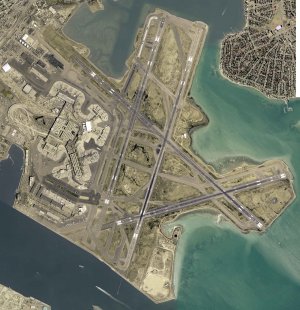FAA to Install Runway Safety Warning System at Boston Logan

Technology that warns pilots about potential runway safety hazards will be installed and tested at Boston Logan International Airport under a partnership between the Federal Aviation Administration (FAA) and the Massachusetts Port Authority (Massport). The test system will be installed in November 2009 and testing will begin the following month, a full two years ahead of the planned national program deployment.
 The system, called Runway Status Lights, uses a series of red lights embedded in the pavement to warn pilots if it is unsafe to cross over or enter a runway. Under the agreement between the FAA and Massport, pilots will begin testing Runway Status Lights at Logan next year. The FAA and Massport are sharing the cost of the system, estimated at $5 million.
Boston will be the first location in the country to test Runway Status Lights for intersecting runways.
These lights add another layer to the safety systems designed to keep our runways safe," said FAA Acting Administrator Robert Sturgell. "They will keep pilots focused and make our runways safer.
Safety and security are our most important priorities at Logan, said Thomas J. Kinton Jr., CEO and Executive Director of the Massachusetts Port Authority. We are pleased that Logan will be among the first airports in the nation to have runway status lights. They will reduce the potential for runway incursions and are an important tool to use in improving airfield safety.
"The new runway status lights are a critical safety improvement to Logans runways and taxiways. Safety should always remain our utmost concern, and the latest improvements are in keeping with that interest. I am pleased that the FAA has dedicated resources to enhance the safety and the efficiency of Massachusetts largest commercial airport, said Senator John F. Kerry.
Pilots approaching a runway equipped with Runway Status Lights will see red lights illuminated if the airports ground surveillance radar detects traffic on or approaching that runway. Clearance to cross or enter a runway must be given by air traffic control. Pilots must verify clearance before proceeding even after the warning lights are no longer illuminated. Runway Status Lights will also be used by vehicle operators.
The system is in place at Dallas/Fort Worth and San Diego at non-intersecting runways and has improved runway safety without reducing capacity or increasing controller workload. The concept for Runway Status Lights was developed at the Massachusetts Institute of Technologys Lincoln Laboratory.
The system, called Runway Status Lights, uses a series of red lights embedded in the pavement to warn pilots if it is unsafe to cross over or enter a runway. Under the agreement between the FAA and Massport, pilots will begin testing Runway Status Lights at Logan next year. The FAA and Massport are sharing the cost of the system, estimated at $5 million.
Boston will be the first location in the country to test Runway Status Lights for intersecting runways.
These lights add another layer to the safety systems designed to keep our runways safe," said FAA Acting Administrator Robert Sturgell. "They will keep pilots focused and make our runways safer.
Safety and security are our most important priorities at Logan, said Thomas J. Kinton Jr., CEO and Executive Director of the Massachusetts Port Authority. We are pleased that Logan will be among the first airports in the nation to have runway status lights. They will reduce the potential for runway incursions and are an important tool to use in improving airfield safety.
"The new runway status lights are a critical safety improvement to Logans runways and taxiways. Safety should always remain our utmost concern, and the latest improvements are in keeping with that interest. I am pleased that the FAA has dedicated resources to enhance the safety and the efficiency of Massachusetts largest commercial airport, said Senator John F. Kerry.
Pilots approaching a runway equipped with Runway Status Lights will see red lights illuminated if the airports ground surveillance radar detects traffic on or approaching that runway. Clearance to cross or enter a runway must be given by air traffic control. Pilots must verify clearance before proceeding even after the warning lights are no longer illuminated. Runway Status Lights will also be used by vehicle operators.
The system is in place at Dallas/Fort Worth and San Diego at non-intersecting runways and has improved runway safety without reducing capacity or increasing controller workload. The concept for Runway Status Lights was developed at the Massachusetts Institute of Technologys Lincoln Laboratory.



.png)

.jpg)



Comments
There are no comments yet for this item
Join the discussion